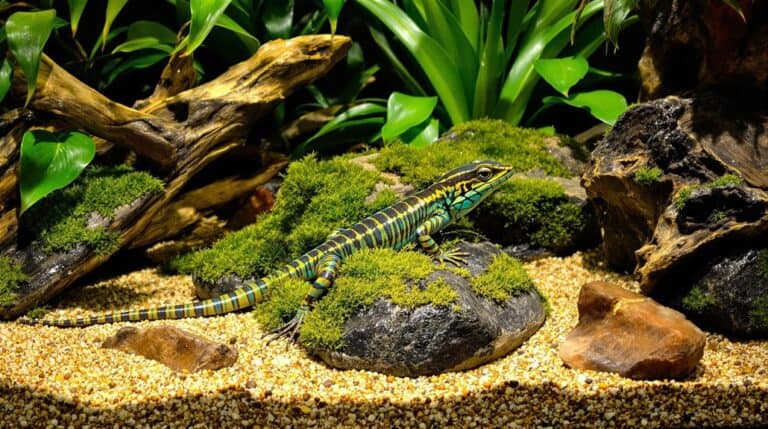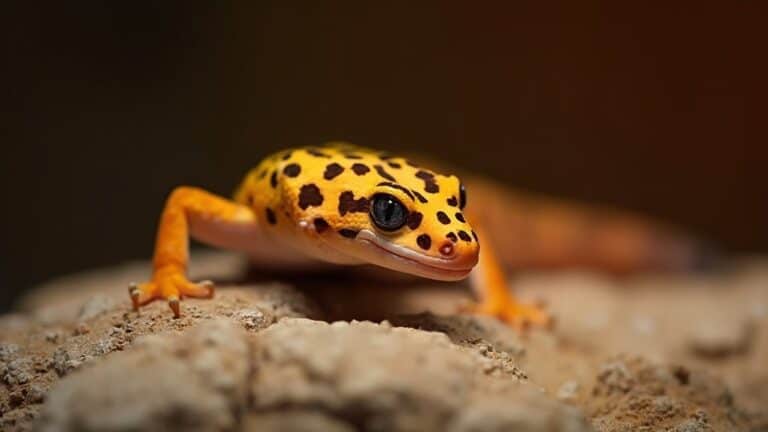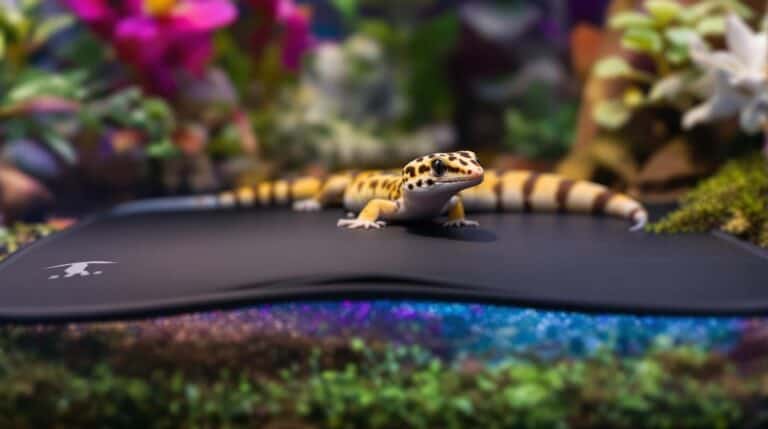Best Heat Lamp for Leopard Gecko
For your leopard gecko, I recommend using a combination of heat sources to guarantee a stable thermal environment. A ceramic heat emitter (CHE) works well for continuous warmth without light, making it great for night time. During the day, an incandescent clear heat bulb or mercury vapor lamp is ideal to simulate natural sunlight and provide the necessary basking temperatures between 94-97°F (34-36°C), essential for your gecko’s digestion. It’s important to regularly monitor the temperature gradients with a digital probe thermometer to maintain the desired thermal conditions. Further exploration can help you perfect your gecko’s habitat setup for their optimum health. Additionally, it’s crucial to provide a warm hide on the heating side of the enclosure to create a secure spot where your leopard gecko can regulate its body temperature comfortably. Pairing overhead heat sources with the best heat mat for leopard gecko setups ensures an evenly distributed heat gradient, particularly beneficial for maintaining warm temperatures at the ground level. By combining these heating elements and regularly assessing enclosure temperatures, you can create a habitat that mirrors their natural environment and promotes their overall well-being.
Key Takeaways
- Select a Ceramic Heat Emitter for nighttime use as it provides heat without light, preserving the gecko’s natural circadian rhythms.
- Choose Mercury Vapor Lamps for daytime, which offer both heat and UVB radiation, crucial for metabolic health and proper basking temperatures.
- Incorporate a heat mat or under-tank heater to ensure adequate belly heat, essential for digestion.
- Use digital probe thermometers to accurately monitor and adjust temperatures within the habitat.
- Opt for adjustable heat lamp setups to easily modify positioning and ensure an appropriate temperature gradient is maintained.
Understanding Gecko Heat Requirements
To guarantee the well-being of your leopard gecko, it is vital to understand and manage their specific heating needs effectively. Leopard geckos require a well-regulated environment to thrive, which includes maintaining a suitable temperature gradient within their habitat. A basking spot with a surface temperature between 94-97°F (34-36°C) is important. Here, they can absorb the necessary heat that aids in digestion and overall physiological regulation.
The enclosure should also provide belly heat, typically achieved through an under-tank heater. This heat source makes certain the substrate is adequately warmed, allowing your gecko to obtain the proper temperature needed for digestive health. It is important that this belly heat covers only part of the base to create a temperature gradient. The cooler end of the habitat should range from 70-77°F (21-25°C).
To consistently monitor these temperatures, I recommend using digital probe thermometers. These devices offer precise readings and can be placed at both the warm and cool ends of the tank, as well as near the basking spot. This setup will help you confirm the ambient air and floor temperatures are always within the safe range, thereby fostering a healthy environment for your leopard gecko.
Types of Heat Lamps Available
Let’s explore the various types of heat lamps available for your leopard gecko’s habitat to guarantee ideal thermal conditions. Selecting the right heat lamp is essential for maintaining a precise temperature gradient, which is important for your gecko’s health and comfort.
- Incandescent Clear Heat Bulbs: These bulbs are great for creating a sun-like environment. They provide robust overhead heating that helps maintain the ambient temperature during the day.
- Ceramic Heat Emitters (CHE): Perfect for nighttime, these emitters produce heat without light, preserving your gecko’s natural nocturnal cycle. They help maintain consistent habitat temperatures without the visual disturbance that can stress the animal.
- Heat Mats/Under Tank Heaters (UTH): These are an excellent choice for providing belly heat, which is crucial for digestion. Heat mats can be placed under the habitat to create a warm floor area, ideal for your leopard gecko to thrive.
Each heat source serves a unique purpose in managing your leopard gecko’s environment. Incandescent bulbs simulate daylight, ceramic emitters safeguard night-time warmth, and heat mats address the significant need for belly heat. Together, they contribute to a well-rounded thermal environment, supporting your desire to offer the best care for your leopard gecko.
Benefits of Mercury Vapor Lamps
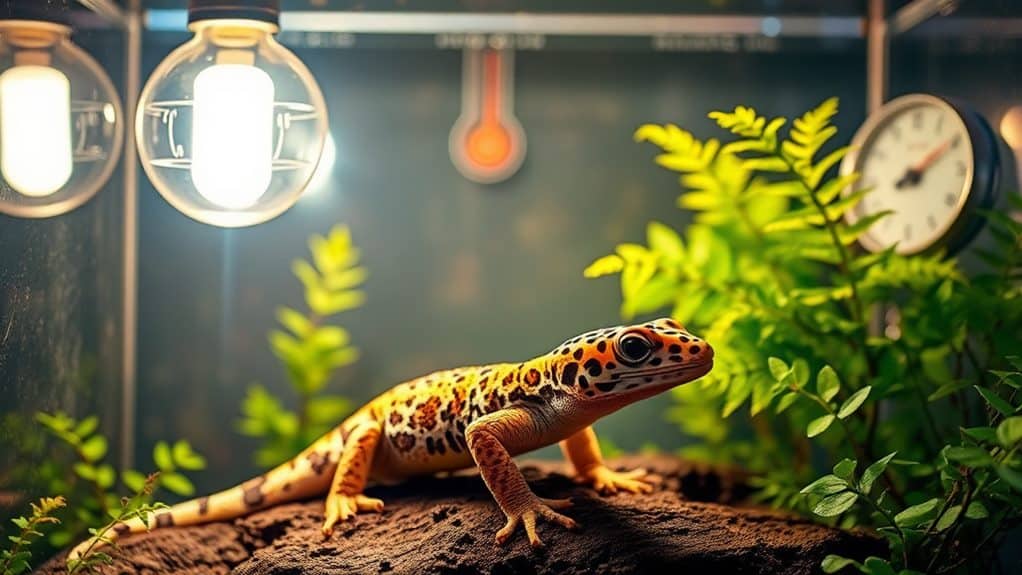
Mercury vapor lamps offer a dual advantage for leopard gecko habitats by providing both essential heat and UVB radiation. These lamps cater to the vital metabolic processes needed for your gecko’s health by emitting a broad light spectrum, including beneficial UVA and UVB rays. This not only encourages natural behaviors like basking but also promotes a healthy appetite.
The heat generated by these lamps creates an ideal basking area with surface temperatures ranging from 95-100°F, simulating the natural sunlight conditions your gecko would enjoy in the wild. This setup contributes considerably to their well-being and encourages typical habitat behaviors.
Moreover, mercury vapor lamps have a longer lifespan than many other heating elements used in terrarium setups. Typically, these bulbs can last up to 12 months before needing replacement, which simplifies maintenance and reduces the frequency of habitat disruptions for your pet. The dual functionality of these lamps also means fewer components in your habitat setup, streamlining the process and minimizing stress for both you and your gecko.
Here’s a quick glance at the advantages:
| Feature | Benefit |
|---|---|
| Heat and UVB Radiation | Supports metabolic processes, simulates natural sunlight |
| Long Lifespan | Up to 12 months before replacement |
| Broad Light Spectrum | Promotes natural behaviors, enhances appetite |
| Simplified Setup | Reduces need for multiple light sources |
| Ideal Basking Temperatures | Creates best basking area |
Setting Up Your Heat Lamp
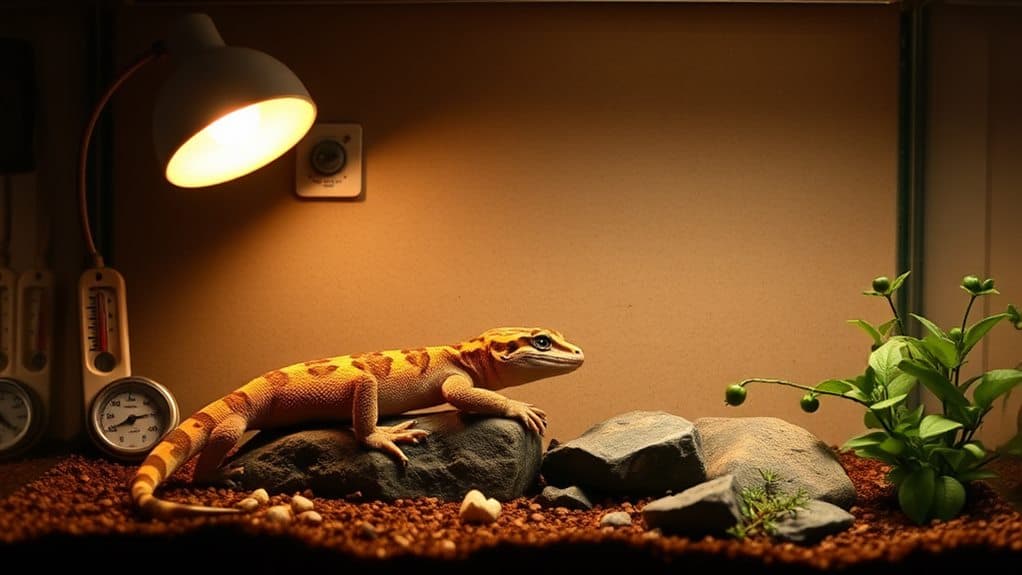
Setting up your heat lamp correctly is crucial for maintaining the health and comfort of your leopard gecko. Leopard Geckos need a carefully regulated environment, and the placement of your heat lamp plays a pivotal role in this. The basking spot temperature should ideally range from 88-92°F during the day. Using a digital thermometer will help you monitor these conditions accurately.
Here’s how you can guarantee a superior setup:
- Positioning: Install the heat lamp directly above the basking area. Adjust the height of the lamp to maintain the desired temperature without overheating.
- Choice of Heater: Opt for ceramic heat emitters or incandescent bulbs that provide necessary warmth while supporting the gecko’s natural light cycle.
- Timing: Incorporate a timer to control the lighting schedule, mimicking a natural cycle with longer daylight hours in summer and shorter in winter.
Make sure to regularly check the temperature with a probe thermometer placed in the basking area. Adjustments might be needed to maintain a constant temperature, considering factors like room temperature changes. Tailoring your heating setup with precision guarantees your gecko thrives in an environment that closely resembles its natural habitat.
Maintaining Optimal Temperatures
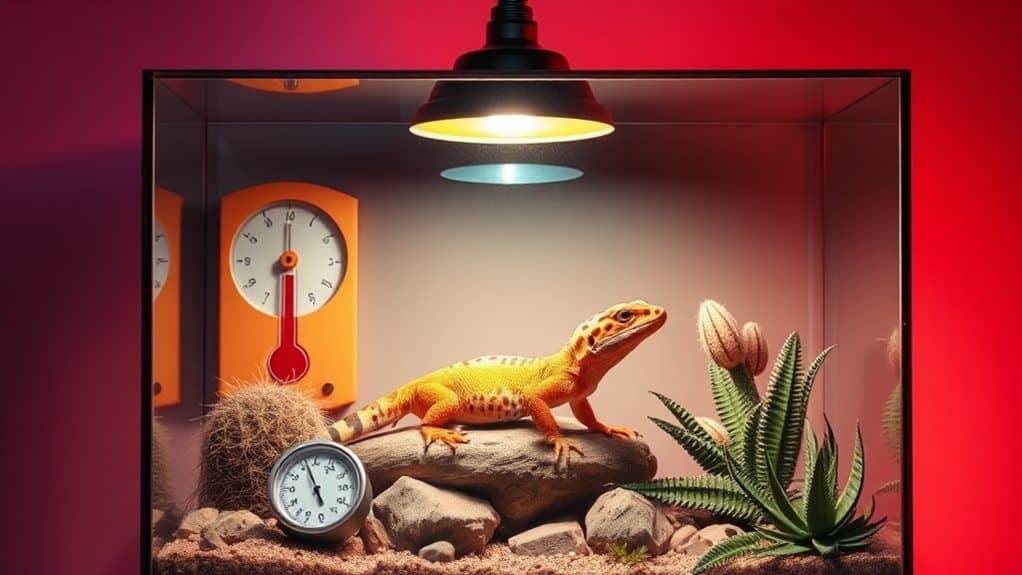
After confirming your heat lamp is properly set up, maintaining ideal temperatures becomes the next significant step in caring for your leopard gecko. Achieving a precise temperature gradient in your Leopard Geckos terrarium is essential for their health and well-being. The heat lamp plays a pivotal role by providing a warm basking spot, necessary for their thermoregulation and digestive processes.
Using a reliable thermometer is non-negotiable to guarantee the heating equipment is performing correctly. You’ll need to regularly check and adjust the temperatures to maintain optimal conditions. It’s important to understand that the ambient air temperature should be slightly cooler than the basking spot but still comfortably warm.
Here’s a quick reference table to help you monitor and adjust the temperatures effectively:
| Zone in Terrarium | Ideal Temperature Range | Importance |
|---|---|---|
| Basking Spot | 88-92°F (31-33°C) | Essential for digestion and thermoregulation |
| Ambient Air | 80-83°F (27-28°C) | Guarantees overall comfort and health |
| Cool Side | 76-78°F (24-26°C) | Allows temperature regulation and rest |
| Overall Gradient | 76-92°F (24-33°C) | Prevents overheating and promotes natural behavior |
| Monitoring | Use reliable thermometer | Vital for maintaining optimal conditions |
Common Heating Mistakes
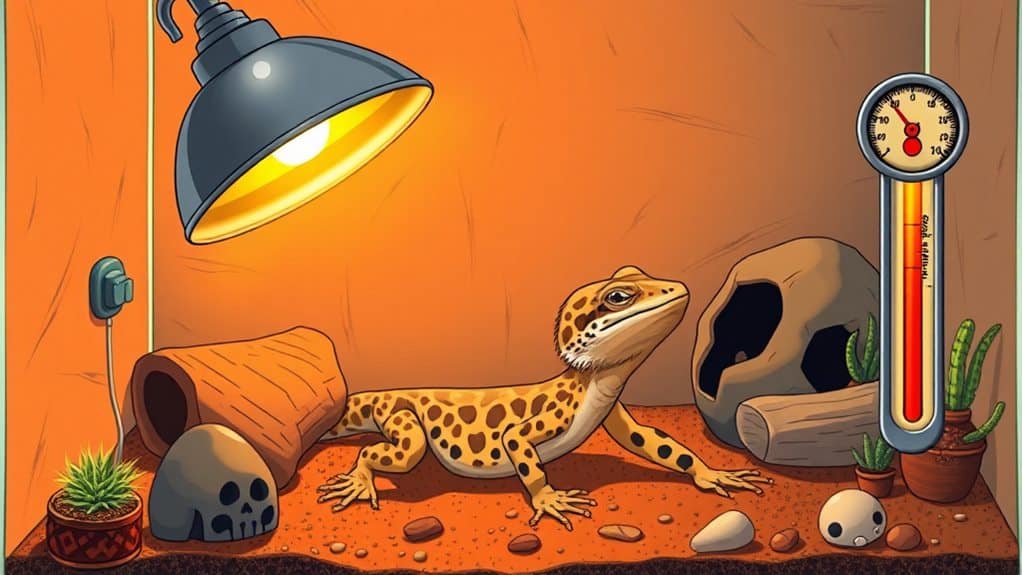
When caring for a leopard gecko, it’s important to avoid common heating mistakes that can threaten their health. Understanding the specific gecko needs is significant for their survival and well-being. Let’s explore some of these errors:
- Improper Temperature Gradient: Many overlook the importance of maintaining a temperature gradient within the enclosure. It’s necessary to provide a basking area heated to 94-97°F and a cooler zone at 70-77°F. Without this range, your gecko cannot regulate its body temperature effectively.
- Nighttime Heat Source Mismanagement: Continually running a heat lamp at night can disrupt your gecko’s natural circadian rhythm. Instead, consider using a heat mat for belly heat, ensuring it’s regulated by a thermostat to avoid burns.
- Incorrect Heat Lamp Wattage and Monitoring: Choosing the right wattage for your heat lamp is essential. Too high can overheat the enclosure, too low might not provide adequate warmth. Always use a digital thermometer to monitor the enclosure temperatures precisely.
These common heating mistakes can be avoided with careful planning and monitoring of your lighting setup. Remember, the goal is to mimic the natural environment of the leopard gecko as closely as possible, fostering a healthy, stress-free habitat.
Conclusion
Curiously, just as I was fine-tuning the heat setup for my own leopard gecko, I discovered an essential tip: maintaining a precise temperature gradient is key. Mercury vapor lamps excel here, offering both heat and vital UVB light. Remember, the right lamp isn’t just about warmth; it’s about mimicking natural conditions to promote your gecko’s health. Avoid common pitfalls by regularly monitoring temperatures. With the right setup, you’ll see your gecko thrive—just as mine has!


